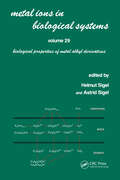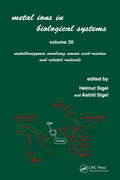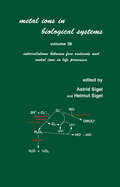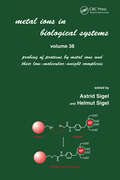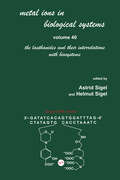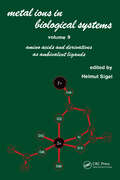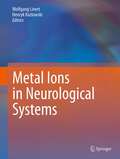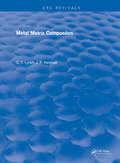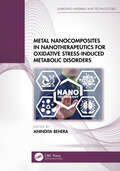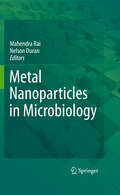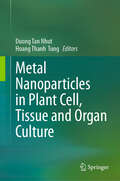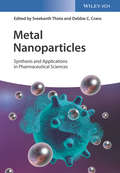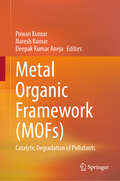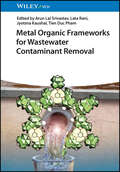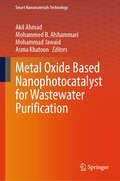- Table View
- List View
Metal Ions in Biological Systems: Volume 29: Biological Properties of Metal Alkyl Derivatives (Metal Ions in Biological Systems)
by Astrid Sigel Helmut SigelThis volume is devoted to the research area regarding the biological properties of metal alkyl derivatives, offering an authoritative account of this subject by 16 scientists. In 11 chapters, Biological Properties of Metal Alkyl Derivatives highlights, in detail, derivatives of germanium, tin, lead, arsenic, antimony, selenium, tellurium, cobalt (vitamin B12 derivatives) and nickel (coenzyme F430), including the role of (mainly) micro-organisms in their formation. The derivatives of indium, thallium, bismuth, various transition metals and mercury are also covered to some extent, as are those of the non-metals silicon, phosphorus and sulfur, and the haloperoxidase route of the biogenesis of halomethanes by fungi and plants. The properties of these alkyl derivatives, their biosynthesis, including mechanistic aspects, their appearance in waters (rivers, lakes, oceans) and sediments, and their physiological and toxic effects are summarized.
Metal Ions in Biological Systems: Volume 30: Metalloenzymes Involving Amino Acid-residue and Related Radicals (Metal Ions in Biological Systems)
by Astrid Sigel Helmut SigelThis volume is devoted solely to the research area of metalloenzymes involving amino acid-residue and related radicals. Topics covered include: general considerations; structure, function and engineering of peroxidases; and ribonucleotide reductase in mammalian systems.
Metal Ions in Biological Systems: Volume 36: Interrelations Between Free Radicals and Metal Ions in Life Processes (Metal Ions In Biological Systems Ser. #28)
by Astrid Sigel Helmut SigelContinues the tradition of excellence established in previous volumes in this acclaimed series. Volume 36 focuses on the vibrant research area concerning the interrelation between free radicals and metal ions and their resulting effects on life processes; it offers an authoritative and timely account of this fascinating area of research in 21 chapters.
Metal Ions in Biological Systems: Volume 37: Manganese and Its Role in Biological Processes (Metal Ions in Biological Systems)
by Helmut Sigel"Highlights the availability of magnesium to organisms, its uptake and transport in microorganisms and plants as well as its role in health and disease of animals and humans including its toxicology."
Metal Ions in Biological Systems: Volume 38: Probing of Proteins by Metal Ions and Their Low-Molecular-Weight Complexes (Metal Ions in Biological Systems)
by Astrid Sigel Helmut SigelVolume 38: Probing of Proteins by Metal Ions and Their Low-Molecular-Weight Complexes focuses on the vibrant area of probing enzymes or proteins by metal ions and small complexes. It offers a summary of the basic characteristics of the amide bond, emphasizing its proton and metal ion interactions, including a quantitative analysis of its hydrolysis and formation. Topics include Peptide bonds, footprinting, protein degradation, protein complexes, and protein cross-linking.
Metal Ions in Biological Systems: Volume 40: The Lanthanides and Their Interrelations with Biosystems (Metal Ions in Biological Systems)
by Astrid Sigel Helmut SigelMany may know lanthanides under the homier name of rare earth elements, but that is less used scientifically because they are, in fact, not at all rare. Highlighting fast-moving research on lanthanides and their interrelations with biosystems, this book emphasizes the recent impact of these metals in biochemical, biological, and medical research, including in magnetic resonance imaging (MRI). The first two chapters outline their abundance and distribution, chemical properties such as oxidation states and ionic radii, and their mobilization through microorganisms like bacteria and fungi. It is written by 38 internationally recognized experts and enriched with nearly 200 illustrations and 1900 references.
Metal Ions in Biological Systems: Volume 41: Metal Ions and Their Complexes in Medication (Metal Ions in Biological Systems #Vol. 41)
by Patrick Graupp Robert J. WronaMetal ions are currently used for such applications as diabetes, anti-inflammatory, rheumatoid arthritis, psychiatric, and anti-ulcer medications, using compounds of vanadium, copper and zinc, gold, lithium, and bismuth, respectively. This text explores these applications in addition to an assessment of chelation therapy, uses in environmental scie
Metal Ions in Biological Systems: Volume 42: Metal Complexes in Tumor Diagnosis and as Anticancer Agents (Metal Ions In Biological Systems Ser. #28)
by Astrid Sigel Helmut SigelOffering an authoritative and timely account by twenty-nine internationally recognized experts, Metal Ions in Biological Systems: Metal Complexes in Tumor Diagnosis and as Anticancer Agents is devoted solely to the vital research area concerning metal complexes in cancer diagnosis and therapy. In fourteen stimulating chapters, the book focuses on d
Metal Ions in Biological Systems: Volume 9: Amino Acids and Derivatives as Ambivalent Ligands (Metal Ions in Biological Systems)
by Helmut SigelThis book focuses on the connection between the chemistry of metal ions and their role for life, and covers complexes with a number of amino acids with chelatable side chain donor atoms. It discusses metal ion-protein interactions and the ligating ambivalency of nucleotides.
Metal Ions in Biology
by A. K. Tyagi Adish Tyagi Rohit Singh ChauhanThis book discusses the inherent need for and significance of metal ions in metabolic reactions. It details their essential elements and mechanistic prospects in regulating biological reactions, as well as covers the broad domain of elements, including main group as well as transition elements, in a comparative and comprehensive manner. Contemporary and advanced topics, such as nuclear medicine and biomineralization, are also covered.Features: Highlights the different behaviors of Fe/Cu proteins and the structural changes during their biological functioning. Discusses the mechanistic prospects of various enzymes and proteins, e.g., Cu‑Zn SOD, zinc finger, and ionophores. Explores the chemical and biological prospects of trace and ultra‑trace elements. Includes biomimetic models of iron and copper. Reviews the criteria for nature selecting metal ions, why only certain elements are essential, and the differences between biologically induced and biologically controlled biomineralization. This book is aimed at graduate students and researchers in chemical engineering, materials science, chemistry, and biological sciences.
Metal Ions in Fungi
by Günther WinkelmannPresents the latest advances in the study of the intracellular fate and transport of metal ions in fungi, emphasizing the mechanisms that regulate cellular concentration. The book explains the expanding relationship between molecular genetics and inorganic biochemistry.
Metal Ions in Neurological Systems
by Henryk Kozlowski Wolfgang LinertMetal ions in the brain are a necessity as well as a poison. The presence of metal ions in the active sites of biological catalysts or metalloproteins and in the biological functioning of nucleic acids is very well documented and they are required for brain activity. On the other hand, metals are very effective in generating oxidative stress. This effect does not only play a role in immunology but also is the root of practically all neurodegenerative disorders by inducing disease via the death of neurons. Managing metal ions in the brain could therefore be an important strategy in the search for therapeutic agents used in the treatment of neurodegenerative diseases. This new title gives an overview to key topics in the area of metal ions in the brain. It focuses on the role of metal ions in neurological systems by describing their advantageous functions as well as their poisonous features. It is therefore of interest for scientists in biochemistry and biophysics, physiology, toxicology as well as for physicians focused on this topic.
Metal Matrix Composites
by C.T. LynchThe concept of reinforcing a material by the use of a fiber is not a new one. The Egyptian brick layer employed the same principle more than three thousand years ago when straw was incorporated into the bricks. More recent examples of fiber reinforced composites are steel-reinforced concrete, nylon and rayon cord reinforced tires, and fiberglass reinforced plastics. In the last several years considerable progress has been made on new composite structures particularly utilizing boron (on tungsten substrate) fibers in various matrices. Many of these advances have been reviewed recently by P. M. Sinclair1 and by Alexander, Shaver, and Withers.2 An excellent earlier survey is available by Rauch Sutton, and McCreight.3 Boron-reinforced epoxy composites are being fabricated and tested as jet engine components, fuselage components, and even as a complete aircraft wing because of the tremendous gain in experimentally demonstrated properties such as modulus, strength, and fatigue resistance, particularly on a weight normalized (e.g., strength/density) basis. Other than glass/epoxy and boron/ epoxy composites and perhaps boron/aluminum, the systems now under study are in the early stages of research and development. These include other boron/metal composites, graphite/polymer, graphite/metal, graphite/graphite, alumina/metal, and aligned eutectic (directionally, solidified) combinations. As Sinclair points out, designers are wary about filamentary composites becausethere is little background information and scant experience.
Metal Micro-Droplet Based 3D Printing Technology
by Jun Luo Lehua Qi He Shen Hongcheng LianThis book introduces a unique 3D printing method that prints metal parts by ejecting metal micro-droplets: a low-cost, contactless, and environmentally friendly 3D printing technology. This book follows a deductive approach to describe the fundamentals of metal droplet-based 3D printing and reveal the relationships and unique features among multiple specific techniques used in droplet-based 3D printing. It starts with a general description of the principles and techniques involved in this technology and then focuses on the details of several specific metal droplet-ejection methods. Next, it puts forward various specific 3D printing techniques and illustrates their applications. This book is a valuable reference for scholars and researchers who work on metal 3D printing and other related areas. It is also used as a textbook for college graduate courses in mechanical manufacturing and material processing.
Metal Nanocomposites in Nanotherapeutics for Oxidative Stress-Induced Metabolic Disorders (Emerging Materials and Technologies)
by Anindita BeheraThis book highlights the role and mechanism of different metal nanocomposites toward oxidative stress-induced metabolic disorders including metabolic pathways affected by oxidative stress and related pathophysiology. The book includes an illustrative discussion about the methods of synthesis, characterization, and biomedical applications of metal nanocomposites. It focuses on the therapeutic approaches for metabolic disorders due to oxidative stress by nano delivery systems. Moreover, the book includes chapters on nanotherapeutic approaches toward different diseases, including diabetes mellitus, obesity, cardiovascular disorders, cancers, and neurodegenerative diseases such as Alzheimer's disease and Parkinson's disease. This book is aimed at researchers and graduate students in nanocomposites, nano delivery systems, and bioengineering. Features Discusses nanocomposites in the field of therapy for diabetes, obesity, cardiovascular disorders, neurodegenerative diseases, and cancers Details the pathophysiology of oxidative stress-induced metabolic disorder Explains mechanisms of the antioxidant potential of metal nanocomposites Discusses pathways to elucidate the therapeutic activity Reviews specific and precise applications of metal nanocomposites against lifestyle-induced disorders
Metal Nanoparticles in Microbiology
by Mahendra Rai Nelson DuranFollowing an introduction to biogenic metal nanoparticles, this book presents how they can be biosynthesized using bacteria, fungi and yeast, as well as their potential applications in biomedicine. It is shown that the synthesis of nanoparticles using microbes is eco-friendly and results in reproducible metal nanoparticles of well-defined sizes, shapes and structures. This biotechnological approach based on the process of biomineralization exploits the effectiveness and flexibility of biological systems. Chapters include practical protocols for microbial synthesis of nanoparticles and microbial screening methods for isolating a specific nanoparticle producer as well as reviews on process optimization, industrial scale production, biomolecule-nanoparticle interactions, magnetosomes, silver nanoparticles and their numerous applications in medicine, and the application of gold nanoparticles in developing sensitive biosensors.
Metal Nanoparticles in Pharma
by Mahendra Rai Ranjita ShegokarCompletely dedicated to the biomedical applications of metal nanoparticles, this book covers the different toxicity problems found in healthcare situations and also provides comprehensive info on the use of metal nanoparticles in treating various diseases. Metal Nanoparticles in Pharma is the first edited volume to set up the discussion for a clinical setting and to target a pharmaceutical audience of academic and industry-based researchers.
Metal Nanoparticles in Plant Cell, Tissue and Organ Culture
by Duong Tan Nhut Hoang Thanh TungThis edited book presents recent developments in the field of plant biotechnology involving highly efficient micropropagation for the commercial exploitation of nanomaterials (such as silver, cobalt, copper, zinc, magnesium, silicon, iron, nickel, manganese, and selenium nanoparticles, etc.). The book covers the concept, preparation, and synthesis of metallic and non-metallic nanoparticles, as well as their application in plant cell, tissue, and organ culture. Metal nanoparticles have gained significant attention in various fields, including plant cell, tissue, and organ culture. Their unique physical, chemical, and biological properties make them attractive candidates for applications in plant science. Nanomaterials are applied as plant growth regulators to improve plantlet quality by enhancing the quality of in vitro shoots, their growth, and development at both in vitro and ex vitro stages. Since then, the application of nanomaterials in micropropagation has paved the way for replacing previous culture mediums with new nanoparticle mediums, bringing better efficiency and simplicity to plant propagation operations. The book discusses mechanisms, explant surface disinfection, media sterilization, abnormal phenomena, morphogenesis, physiological-biochemical processes, and the accumulation of economically valuable crop compounds in culture mediums supplemented or replaced by metal ions with metal nanoparticles. This book will interest teachers, researchers, scientists, capacity builders, and policymakers. Additionally, it serves as additional reading for undergraduate and graduate students in agriculture, forestry, ecology, soil science, and environmental science.
Metal Nanoparticles-Based Nanoplatforms for Colorimetric Sensing: Mechanisms, Applications, and Future Directions (Engineering Materials)
by Arnold A. Lubguban Roberto M. Malaluan Gerard G. Dumancas Arnold C. Alguno Rey Y. Capangpangan Rolen Brian RiveraThis book highlights an in-depth examination of metal nanoparticles as transformative agents in colorimetric sensing technology. Targeted toward researchers, practitioners, and students in nanotechnology, analytical chemistry, and related fields, this book consolidates the latest advancements in nanoparticle-based colorimetric systems for highly sensitive and selective detection. With chapters dedicated to gold, copper, iron, silver, platinum, and palladium nanoparticles, it explores their unique optical and catalytic properties and their role in diverse applications, from biosensing and environmental monitoring to medical diagnostics and food safety.
Metal Nanoparticles: Synthesis and Applications in Pharmaceutical Sciences
by Sreekanth Thota Debbie C. CransA much-needed summary of the importance, synthesis and applications of metal nanoparticles in pharmaceutical sciences, with a focus on gold, silver, copper and platinum nanoparticles. After a brief introduction to the history of metal complexes in medicine and fundamentals of nanotechnology, the chapters continue to describe different methods for preparation of metal nanoparticles. This section is followed by representative presentations of current biomedical applications, such as drug delivery, chemotherapy, and diagnostic imaging. Aimed at stimulating further research in this field, the book serves as an reference guide for academics and professionals working in the field of chemistry and nanotechnology.
Metal Nanoparticles: Synthesis and Applications in Pharmaceutical Sciences
by Sreekanth Thota Debbie C. CransA much-needed summary of the importance, synthesis and applications of metal nanoparticles in pharmaceutical sciences, with a focus on gold, silver, copper and platinum nanoparticles. After a brief introduction to the history of metal complexes in medicine and fundamentals of nanotechnology, the chapters continue to describe different methods for preparation of metal nanoparticles. This section is followed by representative presentations of current biomedical applications, such as drug delivery, chemotherapy, and diagnostic imaging. Aimed at stimulating further research in this field, the book serves as an reference guide for academics and professionals working in the field of chemistry and nanotechnology.
Metal Nanopowders
by Alexander A. Gromov Ulrich TeipelWritten with both postgraduate students and researchers in academia and industry in mind, this reference covers the chemistry behind metal nanopowders, including production, characterization, oxidation and combustion. The contributions from renowned international scientists working in the field detail applications in technologies, scale-up processes and safety aspects surrounding their handling and storage.
Metal Organic Framework (MOFs): Catalytic Degradation of Pollutants
by Pawan Kumar Naresh Kumar Deepak Kumar AnejaThis book presents the fundamental chemistry, synthesis, and classification of Metal Organic Framework (MOFs) for/in catalysis applications. As an introduction, the role of theoretical catalytic degradation studies on MOFs is also covered. The book includes all types of pollutants, i.e., pesticides, plastics, Polycyclic Aromatic Hydrocarbon compounds (PAHs), nitroaromatic compounds, and emerging pollutants degradation studies using MOFs. Finally, the book discusses the challenges and future prospective for catalytic degradation using MOFs. In the last decades, significant attention has been drawn on catalysis applications of Metal Organic Framework (MOFs). It is due to the structural characteristics, i.e., coordination vacancies available in the metal nodes, organocatalytic site of organic linkers, and ligand to metal charge transfer features, etc., of MOFs. Furthermore, some excellent features including presence of pendent groups, functionalization/bio conjugation possibility, optoelectronic properties as hosts, and additional catalytic sites possibility via post-synthetic modification of MOFs have made them potential materials for real-world application.
Metal Organic Frameworks for Wastewater Contaminant Removal
by Arun Lal Srivastav Lata Rani Jyotsna Kaushal Tien Duc PhamMetal Organic Frameworks for Wastewater Contaminant Removal Discover a groundbreaking new wastewater decontamination technology The removal of wastewater contaminants is a key aspect of the water cycle, allowing water to be fed safely back into circulation within a given ecosystem. Metal-Organic Frameworks (MOFs) are a new class of porous materials which can reversibly bind and sequester both metal ions and potentially harmful organic substances, giving them a potentially crucial role in the targeted removal of wastewater contaminants. They may also enable significant cost and energy savings over now-conventional ion exchangers in water treatment plants. Metal Organic Frameworks for Wastewater Contaminant Removal provides an accessible, practical guide to the development, evaluation, and potential applications of MOFs in maintaining the water cycle. It begins with an overview of the major metallic and non-metallic contaminants found in wastewater and their interactions with major MOF-based materials, before moving to the challenges and opportunities provided by MOFs in the pursuit of a sustainable, energy-efficient water cycle. The result is a groundbreaking resource in the ever-expanding global fight to keep water clean and safe. Metal Organic Frameworks for Wastewater Contaminant Removal readers will also find: MOF technology and its water treatment applications discussed in depth for the first time in a major publication Comparison with existing decontamination technologies and environmental risk assessment Applications for environmental as well as industrial toxicants based on recent research and on case studies Metal Organic Frameworks for Wastewater Contaminant Removal is indispensable for water chemists, chemical engineers, environmental chemists, and for any researchers or industry professionals working with water decontamination technologies.
Metal Oxide Based Nanophotocatalyst for Wastewater Purification (Smart Nanomaterials Technology)
by Mohammad Jawaid Akil Ahmad Mohammed B. Alshammari Asma KhatoonThis book presents the latest studies of metal oxide decorated nanophotocatalyst for pollutant removal from water bodies. Metal oxide-based nanophotocatalyst is currently considered an efficient material for pollutant removal as compared to other available materials due to its unique characteristics such as low cost, high regenerability, high photocatalytic degradation capacity, environmentally friendly and sustainability. This book elaborates on the basic synthetic route of the nanophotocatalyst to make it highly efficient such as; the presence of active sites, high mechanical strength, conductivity and thermal stability properties. These sustainable and efficient metal oxide-based nanophotocatalyst materials have significant environmental applications and can be applied in different fields. This material has the potential to clean up the different pollutants like volatile organic compounds, CO2 capture, organic and inorganic toxic pollutants, pesticides and colour compounds from the environment. This book gives a sound knowledge of metal oxide-based nanophotocatalyst to the audience regarding the modern design of photocatalytic degradation materials and manufacturing engineering with numerous example illustrations, methods and results for graduate students, researchers and industrialists. Readers will have a quick reference by exploring the research literature on the subject with commercial value-added research applications of metal oxide-based nanophotocatalyst materials.
